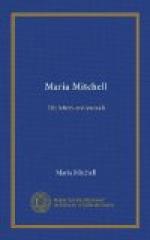As a little girl, Maria was not a brilliant scholar; she was shy and slow; but later, under her father’s tuition, she developed very rapidly.
After the close of the war of 1812, when business was resumed and the town restored to its normal prosperity, Mr. Mitchell taught school,—at first as master of a public school, and afterwards in a private school of his own. Maria attended both of these schools.
Mr. Mitchell’s pupils speak of him as a most inspiring teacher, and he always spoke of his experiences in that capacity as very happy.
When her father gave up teaching, Maria was put under the instruction of Mr. Cyrus Peirce, afterwards principal of the first normal school started in the United States.
Mr. Peirce took a great interest in Maria, especially in developing her taste for mathematical study, for which she early showed a remarkable talent.
The books which she studied at the age of seventeen, as we know by the date of the notes, were Bridge’s “Conic Sections,” Hutton’s “Mathematics,” and Bowditch’s “Navigator.” At that time Prof. Benjamin Peirce had not published his “Explanations of the Navigator and Almanac,” so that Maria was obliged to consult many scientific books and reports before she could herself construct the astronomical tables.
Mr. Mitchell, on relinquishing school-teaching, was appointed cashier of the Pacific Bank; but although he gave up teaching, he by no means gave up studying his favorite science, astronomy, and Maria was his willing helper at all times.
Mr. Mitchell from his early youth was an enthusiastic student of astronomy, at a time, too, when very little attention was given to that study in this country. His evenings, when pleasant, were spent in observing the heavens, and to the children, accustomed to seeing such observations going on, the important study in the world seemed to be astronomy. One by one, as they became old enough, they were drafted into the service of counting seconds by the chronometer, during the observations.
Some of them took an interest in the thing itself, and others considered it rather stupid work, but they all drank in so much of this atmosphere, that if any one had asked a little child in this family, “Who was the greatest man that ever lived?” the answer would have come promptly, “Herschel.”
Maria very early learned the use of the sextant. The chronometers of all the whale ships were brought to Mr. Mitchell, on their return from a voyage, to be “rated,” as it was called. For this purpose he used the sextant, and the observations were made in the little back yard of the Vestal-street home.
There was also a clumsy reflecting telescope made on the Herschelian plan, but of very great simplicity, which was put up on fine nights in the same back yard, when the neighbors used to flock in to look at the moon. Afterwards Mr. Mitchell bought a small Dolland telescope, which thereafter, as long as she lived, his daughter used for “sweeping” purposes.




